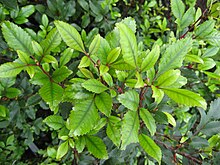

| Kāmahi | |
|---|---|

| |
| Scientific classification | |
| Kingdom: | Plantae |
| Clade: | Tracheophytes |
| Clade: | Angiosperms |
| Clade: | Eudicots |
| Clade: | Rosids |
| Order: | Oxalidales |
| Family: | Cunoniaceae |
| Genus: | Pterophylla |
| Species: |
P. racemosa
|
| Binomial name | |
| Pterophylla racemosa | |
| Synonyms[1] | |
| |
Pterophylla racemosa, known as the kāmahi, is an evergreen tree native to New Zealand. It is part of the Pterophylla genus which mostly includes sub-tropical species, but the kāmahi is found in a variety of New Zealand climates from coastal areas to high-elevation inland areas.
A very common tree throughout New Zealand, kāmahi is evergreen that grows up to 25 m in height (rarely higher) with a trunk up to 24 cm (Wardle & MacRae, 1966). The tree has dark green leathery leaves approximately 7.5cm long and 4cm wide. It produces masses of creamy flowers between October and March which have a sweet, scented smell. The flowers form in erect spikes like clusters and are highly attractive to a range of insects and birds.[2][3]
Kāmahi is native to New Zealand although the genus Pterophylla has a more widespread distribution in Madagascar, Malesia, and the southwest Pacific. Most species of this genus are tropical or sub-tropical. In New Zealand, however, kāmahi is found south in colder climate such as alpine terrain.[4]
Kāmahi appears in lowland, montane, and subalpine forests and shrubland from central North Island south to Stewart Island.[5]
Kāmahi’s habitat is coastal to subalpine. It’s very commonly widespread in coastal, lowland and montane forest, often becoming dominant in higher elevation montane forest in the higher areas of the North Island and western South Island.[6]
Kāmahi is durable, hardy, and persistent meaning it will grow in most situations. Kāmahi often starts life as a dense shrub; however, given the space, it can develop into a hulking tree that grows erratically.[7] The white candle-like flowers that bloom in spring open to release fine seeds to be blown in the wind. Spreading their seed easily in spring.[8] It’s a slow growing plant that takes it time to establish roots, however once established they will grow to 25 m at their best.
Kāmahi prefers well drained sites and tolerates infertile soil reasonably well. It is found on hillslopes, roadside cuttings and can even start out life perched on the trunks of tree ferns.[8] It has medium water requirements, preferring the soil to become dry between waterings. Kāmahi enjoys free draining soil which is suited to silt and sand-based soil, although it is accepted that this tree does not necessarily need particular climates in which it lives it is an adaptable plant that grows in many diverse areas.[9]
Kāmahi has benefits in spring when it flowers because bees use its nectar for honey that is becoming more and more popular and well known.[10] Plenty of insects and invertebrates use the trees to feed off and move around. A study in the Ōrongorongo Valley forest near Wellington called “Invertebrate fauna of four tree species in Ōrongorongo valley, New Zealand, as revealed by truck traps” discovered that tree trunks provide an important pathway (especially at night) for many ground-living invertebrates that move from the forest floor to feed or breed on tree stems and in the canopy.[11]
The Department of Conservation are looking at a kāmahi forest on the Kaitake Range monitoring trees seeing how they are progressing. This investigation brings up the problem of possums and the damage they do to kāmahi trees. Their results showed how possums were damaging the trees from the canopy to the ground floor. This shows that one of the only threats to kāmahi is an introduced species. Kāmahi have not adapted and have very little protection against invaders, however with kāmahi being as a very common tree throughout New Zealand the possum problem with pest control added on should not pose much of a threat to the species.[12]
The fruit is about 5mm in diameter.[13] The berries are not edible according to Crowe, the main authority on New Zealand edibles. He said the first error probably started with the confusion with tawa, which has a similar Māori name. He does not, however, say it is actually poisonous and it has not found out if it is anywhere (Nicholls, 2000). It was, however, very valuable to Māori for other uses (see below).
Before the arrival of Europeans, kāmahi was so valuable to Māori and because of this it was protected by tapu (spiritual restriction, means that kāmahi was almost sacred to Māori). Back when the land was being transformed by Māori and being set up for cultivation, there are legends that say Māori were careful not to cut down all the tree’s limbs, if they did they or their spouse may suffer unfortunate consequences.[7] Kāmahi bark was a rich source of tannins which were used to dye cloaks and mats and to preserve fishing lines.[7]
Inner bark is a purgative decoction. "Bark from west side of the tree, from which the outer rind has been scraped off, is steeped in hot water and the decoction taken internally as an aperient in cases of abdominal and thoracic pain". Bark infused in boiling water is a good tonic. Inner bark is also a laxative.[14]
{{cite web}}: CS1 maint: multiple names: authors list (link)
![]() Media related to Weinmannia racemosa at Wikimedia Commons
Media related to Weinmannia racemosa at Wikimedia Commons
| Pterophylla racemosa |
|
|---|---|
| Weinmannia racemosa |
|